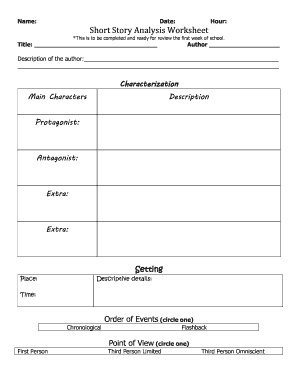Loading

Get Short Story Analysis Worksheet
How it works
-
Open form follow the instructions
-
Easily sign the form with your finger
-
Send filled & signed form or save
How to fill out the Short Story Analysis Worksheet online
This guide provides clear, step-by-step instructions for completing the Short Story Analysis Worksheet online. Whether you're new to the process or need a refresher, this comprehensive guide will support you in effectively filling out the form.
Follow the steps to complete the Short Story Analysis Worksheet online.
- Press the ‘Get Form’ button to retrieve the Short Story Analysis Worksheet, which you can then open in your chosen editor.
- Begin by filling in the title of the short story in the designated field. This will be the name of the work you are analyzing.
- Next, enter the author's name in the author field. This should include the full name as it appears in publication.
- Provide a brief description of the author. This section allows you to summarize their background, key works, and significant contributions to literature.
- In the characterization section, identify the main characters. Fill in the description for the protagonist, antagonist, and any additional characters, using specific traits, motivations, or roles.
- Proceed to the setting section. Specify the place where the story unfolds and include descriptive details that evoke the environment and context.
- Complete the time aspect, noting when the events of the story take place. This could involve specific dates, seasons, or a general time period.
- In the order of events section, circle your choice between chronological or flashback to indicate how the narrative unfolds.
- Select the point of view by circling either first person, third person limited, or third person omniscient to clarify the narrative perspective.
- Describe the mood by providing an adjective and remarks that capture the emotional atmosphere of the story.
- Next, indicate the tone of the story with another adjective and include descriptive details that explain this choice.
- For the plot section, outline the conflict, noting if it is internal or external along with a description explaining your choice.
- Fill in the exposition and rising action, summarizing key events leading up to the story's climax.
- Identify the climax itself, specifying the turning point of the narrative.
- Complete the falling action section, detailing what transpires after the climax that leads towards resolution.
- Conclude this section with the denouement, summarizing the resolution of the story.
- In the theme section, provide your overall impressions and opinions regarding the story, reflecting on the key messages or underlying themes.
- Once you have filled out the entire worksheet, ensure to save your changes. You may then download, print, or share the completed form as needed.
Take a moment to complete your Short Story Analysis Worksheet online for a deeper understanding of the story.
Related links form
5 Important Elements of a Short Story. The 5 key elements that make up a short story are: ... Character. A character is a person, or sometimes an animal, who takes part in the action of a short story or other literary work. ... Setting. Setting is the time and place that a story occurs. ... Theme. ... Conflict. ... Plot. ... Plot Diagram. ... Exposition.
Industry-leading security and compliance
US Legal Forms protects your data by complying with industry-specific security standards.
-
In businnes since 199725+ years providing professional legal documents.
-
Accredited businessGuarantees that a business meets BBB accreditation standards in the US and Canada.
-
Secured by BraintreeValidated Level 1 PCI DSS compliant payment gateway that accepts most major credit and debit card brands from across the globe.


